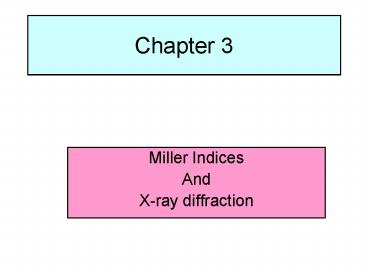Miller Indices PowerPoint PPT Presentation
1 / 12
Title: Miller Indices
1
Chapter 3
- Miller Indices
- And
- X-ray diffraction
2
Directions in a crystal lattice Miller Indices
Vectors described by multiples of lattice
constants uavbwc e.g., the vector in the
illustration crosses the edges of the unit cell
at u1, v1, c1/2 Arrange these in brackets,
and clear the fractions 1 1 ½ 2 2 1
3
Negative directions have a bar over the
number e.g.,
Families of crystallographically equivalent
directions, e.g., 100, 010, 001 are written
as ltuvwgt, or, in this example, lt100gt
4
Directions in HCP crystals
a1, a2 and a3 axes are 120o apart, z axis is
perpendicular to the a1,a2,a3 basal
plane Directions in this crystal system are
derived by converting the u'v'w' directions to
uvtw using the following convention
n is a factor that reduces uvtw to smallest
integers. For example, if u'1, v'-1, w'0,
then uvtw
5
Crystallographic Planes
To find crystallographic planes are represented
by (hkl). Identify where the plane intersects
the a, b and c axes in this case, a1/2, b1,
c8 Write the reciprocals 1/a, 1/b, 1/c
Clear fractions, and put into parentheses (hkl)(
210)
6
If the plane interesects the origin, simply
translate the origin to an equivalent
location. Families of equivalent planes are
denoted by braces e.g., the (100), (010),
(001), etc. planes are denoted 100
7
Planes in HCP crystals are numbered in the same
way e.g., the plane on the left intersects a11,
a20, a3-1, and z1, thus the plane is
8
X-RAYS TO CONFIRM CRYSTAL STRUCTURE
Incoming X-rays diffract from crystal planes.
Adapted from Fig. 3.2W, Callister 6e.
Measurement of Critical angles, qc,
for X-rays provide atomic spacing, d.
25
9
X-ray diffraction and crystal structure
- X-rays have a wave length, l?0.1-10Å.
- This is on the size scale of the structures we
wish to study
X-rays interfere constructively when the
interplanar spacing is related to an integer
number of wavelengths in accordance with Braggs
law
10
Because of the numbering system, atomic planes
are perpendicular to their corresponding vector,
e.g., (111) is perpendicular to 111 The
interplanar spacing for a cubic crystal is
Because the intensity of the diffracted beam
varies depending upon the diffraction angle,
knowing the angle and using Braggs law we can
obtain the crystal structure and lattice parameter
11
Rules for diffracting planes
By comparing the ratios of the diffracted peaks,
we can determine the ratios of the diffracting
planes and determine the corresponding Miller
indices
12
Braggs law only describes the size and shape of
the unit cell If there are parallel planes
inside the unit cell, their reflections can
interfere constructively and result in zero
intensity of the reflected beamhence, different
crystal structures will only allow reflections of
particular planes according to the following
rules

